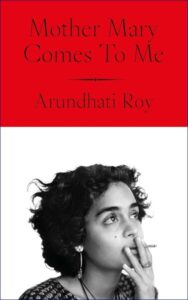Arundhati Roy’s much-awaited memoir, Mother Mary Comes To Me, tackles Roy’s writing career, India’s sweeping political instability, and most of all, a reckoning with an exhilarating character: her mother, Mary Roy. From Roy’s village, fictionalised even here as “Ayemenem”, to the chaotic urban sprawl of Delhi, the book covers Roy’s rocky childhood, her brief architectural foray, her sudden and dizzying literary stardom, and eventually, her settling into the role as one of India’s most beloved—and most widely politicised—writers.
Through the narrative, Mary Roy simmers behind every scene, often explicitly (there are many scenes recounting the abuse endured by Roy and her brother at the hands of their mother) and more often, implicitly (“Even up to my very last day with her I never managed to get used to or anticipate the sudden shifts … In truth I am constructed from its debris”).
When Mary is Roy’s total focus, the writing feels electric.

Arundhati Roy (Hamish Hamilton, Scribner, September 2025)
Roy’s work, particularly her most famous book—The God of Small Things—is entwined throughout Mother Mary Comes To Me, from contextual holes of her own life in Ayemenem to the writing process of the book, which forced her—as someone in her thirties—to acknowledge that childhood was something she had to survive. In one of the most exciting passages in the book, which takes place early on, Roy recalls her mother reading a passage from The God of Small Things in which the protagonist twins are shoved from one parent to the other, both saying, “You take them, I don’t want them.”
What Roy had believed was fiction turned out to be reality. Mary, insistent that Roy was too young to remember the scene, and Roy, insistent that it was supposed to be fictitious, had “never felt the weight or the sorrow of this memory.” Yet somewhere, it served as proof that we are all “a living, breathing soup of memory and imagination—and that we may not be the best arbiters of which is which.” With the opening assertion of true fictions and false realities, the tone of the memoir is set: a soupy, half-magical haze that Roy weaves into a narrative.
When Mary is Roy’s total focus, the writing feels electric. Part of what makes Mother Mary Comes To Me such a successful narrative is the grit and depth of the subject, Mary Roy. Abusive, cruel, and above all else, a survivor. Mary Roy flits from catastrophic failures—at one point, the family of three was starving and squatting in a relative’s house only to eventually be kicked out—to legacy-definining successes; the Travancore Christian Succession Act, which stated that daughters had no right to their father’s property, was legally challenged before the Indian Supreme Court by Mary, and she won. Mary is, at every step of the way, impossible to understand—most of all for Arundhati Roy. It is the love, always mercurial, between the two of them that suspends the narrative, well supplemented with a wide array of side-characters ranging from a blind, violin-playing grandmother to a Marxist, factory-owning uncle.
Mother Mary Comes To Me is a victory lap.
Despite the book’s many strengths, there are times when the narrative gets lost within itself. Scenes are repeated, and situations are alluded to but then explained only a few pages later, thus dissolving the possibility of any tension. Yet the charm of Roy’s writing overrides any such misgivings: such as this passage on meeting her future partner, “He was Jesus. He was rock ’n’ roll. And he had walked on water all the way from Woodstock to Kerala just to meet me.”
Mother Mary Comes To Me is a victory lap for an Indian activist and educator who relentlessly fought for a smarter India; but most of all, it’s a beautiful peek into a fascinating person, told with Arundhati Roy’s customary whimsy. The memoir is a treasure for those who are fans of Roy, and an intensely readable, charming introduction for those unfamiliar with her work.


You must be logged in to post a comment.